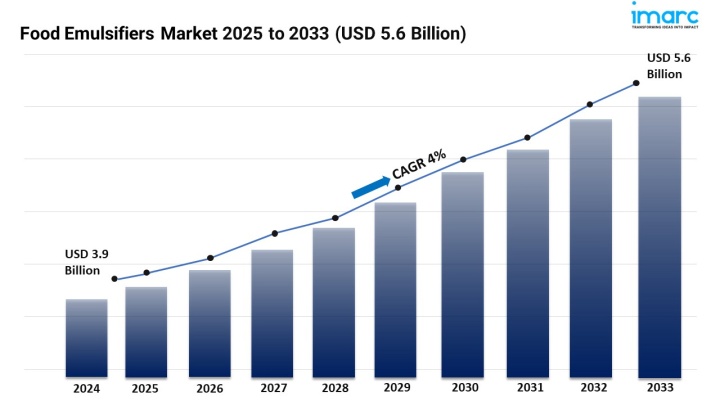

Market Overview:
The Food Emulsifiers Market is witnessing robust growth, driven by Rising Demand for Processed Foods, Advancement in Clean Label Ingredients, and Expansion of the Bakery and Confectionery Industry. According to IMARC Group's latest research publication, "Food Emulsifiers Market : Global Industry Trends, Share, Size, Growth, Opportunity and Forecast 2025-2033", The global food emulsifiers market size was valued at USD 3.92 Billion in 2024. Looking forward, IMARC Group estimates the market to reach USD 5.6 Billion by 2033, exhibiting a CAGR of 4.00% from 2025-2033.
This detailed analysis primarily encompasses industry size, business trends, market share, key growth factors, and regional forecasts. The report offers a comprehensive overview and integrates research findings, market assessments, and data from different sources. It also includes pivotal market dynamics like drivers and challenges, while also highlighting growth opportunities, financial insights, technological improvements, emerging trends, and innovations. Besides this, the report provides regional market evaluation, along with a competitive landscape analysis.
Download a sample PDF of this report: https://www.imarcgroup.com/food-emulsifiers-market/requestsample
Our report includes:
Growth Factors in the Food Emulsifiers Industry:
The growing preference for convenient, ready-to-eat, and shelf-stable food products is driving the demand for food emulsifiers worldwide. These additives are vital in improving texture, extending shelf life, and enhancing the mouthfeel of processed foods such as sauces, baked items, and frozen meals. With urban populations relying heavily on packaged foods, manufacturers are innovating to create stable emulsions that resist separation during storage and transport. Fast-paced lifestyles, coupled with the expansion of online grocery delivery and quick-service restaurants, are fueling consumption of processed products, further amplifying emulsifier use across diverse formulations from spreads and dressings to dairy alternatives.
Clean label innovation is redefining the emulsifiers landscape as consumers seek transparency and natural origins. Food manufacturers are increasingly substituting synthetic emulsifiers with natural alternatives derived from plant, seaweed, or microbial sources. Ingredients such as sunflower lecithin, oat extracts, and enzymatically modified starches are gaining traction in organic and premium food categories. These alternatives meet rising regulatory and consumer expectations for safe, traceable, and chemical-free ingredients. Companies are investing in sustainable sourcing and fermentation-based emulsifiers that maintain functionality while enhancing consumer trust. As clean label claims dominate packaging, natural emulsifiers are becoming central to modern product development and brand differentiation.
The rapid growth of the bakery and confectionery industries continues to underpin strong emulsifier demand. In baked goods, emulsifiers improve dough stability, aeration, and shelf life, ensuring softness and uniform texture. Confectionery applications benefit from smooth chocolate emulsions and consistent fillings. With rising disposable incomes and urban café culture, the consumption of pastries, cookies, and premium chocolates has surged globally. Additionally, bakery chains are experimenting with healthier recipes—low sugar, gluten-free, and high-protein—that still rely on emulsifiers for texture management. As artisanal and mass-market segments expand simultaneously, emulsifiers play a critical role in enhancing both quality and scalability.
Key Trends in the Food Emulsifiers Market
The evolution of plant-based and allergen-free emulsifiers is reshaping product innovation across the food industry. Manufacturers are leveraging sources like quinoa, chickpeas, algae, and microalgae to replace conventional egg- and soy-based emulsifiers. These alternatives provide excellent stability in vegan beverages, dairy substitutes, and plant-based meats. They cater to consumers seeking allergen-free and ethical products while supporting sustainability goals. Food giants are reformulating legacy products to accommodate plant-based preferences, particularly in Europe and North America. With increased awareness around food sensitivities and the surge of vegan consumers, plant-derived emulsifiers are becoming key to cleaner, more inclusive food formulations.
The demand for healthier food formulations is driving the use of emulsifiers in reduced-fat and low-calorie products. These ingredients mimic the richness of fats, allowing food brands to deliver indulgence without compromising on health. In dairy alternatives, salad dressings, and baked snacks, emulsifiers ensure smooth texture and consistency despite lower fat content. The global obesity prevention movement and government reformulation targets are accelerating adoption. Manufacturers are using multi-functional emulsifiers that balance taste and nutrition, appealing to calorie-conscious consumers. This synergy of indulgence and wellness continues to position emulsifiers as essential components in the evolving health-centric food landscape.
Emerging technologies in food processing are revolutionizing emulsifier applications. Techniques such as nanoemulsion, high-pressure homogenization, and microencapsulation enhance ingredient functionality and improve product quality. These innovations enable emulsifiers to perform in complex formulations, including protein-fortified beverages, nutraceuticals, and functional snacks. Automation and smart dosing systems also ensure consistent blending, reducing waste and improving cost efficiency. Furthermore, novel bio-based emulsifiers are being designed to withstand extreme processing conditions without affecting flavor or appearance. As manufacturers pursue innovation-driven efficiency, technology-enabled emulsifiers are set to redefine production capabilities and expand their role in next-generation food manufacturing.
We explore the factors driving the growth of the market, including technological advancements, consumer behaviors, and regulatory changes, along with emerging Food Emulsifiers Market trends.
Leading Companies Operating in the Global Food Emulsifiers Industry:
Food Emulsifiers Market Report Segmentation:
By Type:
Mono and di-glycerides and their derivatives represented the largest segment as they are versatile emulsifiers widely used in various food products.
By Application:
Dairy and frozen desserts accounted for the largest market share due to the frequent use of emulsifiers in products like ice creams and yogurts.
By Source:
Plant source exhibits a clear dominance in the market as consumer preferences for natural and clean label ingredients.
Regional Insights:
Europe enjoys the leading position in the food emulsifiers market on account of its strong focus on food quality and innovation and strict regulatory standards.
Note: If you require specific details, data, or insights that are not currently included in the scope of this report, we are happy to accommodate your request. As part of our customization service, we will gather and provide the additional information you need, tailored to your specific requirements. Please let us know your exact needs, and we will ensure the report is updated accordingly to meet your expectations.
About Us:
IMARC Group is a global management consulting firm that helps the world’s most ambitious changemakers to create a lasting impact. The company provide a comprehensive suite of market entry and expansion services. IMARC offerings include thorough market assessment, feasibility studies, company incorporation assistance, factory setup support, regulatory approvals and licensing navigation, branding, marketing and sales strategies, competitive landscape and benchmarking analyses, pricing and cost research, and procurement research.
Contact Us:
IMARC Group
134 N 4th St. Brooklyn, NY 11249, USA
Email: sales@imarcgroup.com
Tel No:(D) +91 120 433 0800
United States:+1–201971–6302
